MiniCAM is a fast and flexible, partial-equilibrium model designed to examine long-term, large-scale changes in global and regional energy and agriculture systems. It was originally developed by the Pacific Northwest National Laboratory in the USA in the 1980’s and continues evolve in its capability and detail [1]. A user version of the model is available for free upon request from [2], but follow-up support is not provided. The model has several hundred users (but the number of these that are active is unknown) and it takes several months to learn the complete functionality of the model.
MiniCAM has global coverage in the form of 14 distinct regions and the projects economic activity, energy consumption, and energy and land-use change emissions in 15-year time steps from 1990 through 2095. Markets are defined for oil (conventional and unconventional), gas, coal, biomass, uranium, carbon, and agricultural products (no markets for labour and capital). MiniCAM’s framework is based on four modules which simulate (1) energy supply and demand, (2) agriculture and land-use (3) atmospheric composition and global-mean climate changes and (4) regional patterns of climate change using the regional climate change scenario. MiniCAM has a strong focus on energy supply technologies. A wide range of technologies, fuels, and energy carriers can be used to supply end-use energy demands, and transformation losses are accounted for throughout the supply system. Technologies include electricity generation (from all thermal and renewable technologies except CHP plants, wave and tidal), hydrogen production, synthetic fuel production, and geologic carbon sequestration from fossil fuels (during electricity generation, hydrogen production, and synthetic fuel production). However, district heating, PHES and CAES are not considered. MiniCAM contains a large set of parameters to simulate technical change over time and these rates of change can be varied at each 15-year time step. It is specifically designed to address issues associated with global change, including (1) projecting baseline carbon dioxide emissions over time, (2) projecting other radiatively important gases (e.g., methane, nitrous oxide, sulphur dioxide, reactive gases), (3) evaluating the energy-system, emissions, and other consequences of various technological options, (4) evaluating some aspects of potential climate change, e.g., temperature change, sea-level rise, (5) providing a measure of the carbon price, in dollars per metric ton for an emissions target, and (6) providing a measure of the overall cost of meeting an emissions target.
Previously MiniCAM has been used to evaluate the impact of oil and nuclear power in the past and future [3], analyse the feasibility of GHG stabilisation by 2100 [4], investigate the future contribution of the transport sector to GHG reductions [5], and to study the economic and technological requirements for various stabilisation levels of GHG [6]. Finally, MiniCAM has been used to simulate a suite of advanced technology including renewable-energy and energy efficiency [7].
References
- MiniCAM, Pacific Northwest National Laboratory, 26th April 2009, http://www.pnl.gov/gtsp/research/ minicam.stm.
- The Joint Global Change Research Institute, Pacific Northwest National Laboratory and University of Maryland, 15th June 2009, http://www.globalchange.umd.edu/.
- Toth, F. L. & Rogner, H.-H., Oil and nuclear power: Past, present, and future. Energy Economics, 28(1), pp. 1-25, 2006.
- Thomson, A. M., César Izaurralde, R., Smith, S. J. & Clarke, L. E., Integrated estimates of global terrestrial carbon sequestration. Global Environmental Change, 18(1), pp. 192-203, 2008.
- Kim, S. H., Edmonds, J., Lurz, J., S.J., S. & Wise, M., The ObjECTS framework for integrated assessment: Hybrid modeling of transportation. Energy Journal, 27(2), pp. 63-91, 2006.
- Clarke, L. E., Edmonds, J. A., Jacoby, H. D., Pitcher, H. M., Reilly, J. M. & Richels, R. G. Scenarios of Greenhouse Gas Emissions and Atmospheric Concentrations. U.S. Climate Change Science Program and the Subcommittee on Global Change Research, 2007, http://www.climatescience.gov/Library/sap/sap2-1/finalreport/sap2-1a-final-all.pdf.
- Clarke, L. E., Wise, M., Edmonds, J., Placet, M., Kyle, P., Calvin, K., Kim, S. & Smith, S. CO2 Emissions Mitigation and Technological Advance: An Updated Analysis of Advanced Technology Scenarios. Pacific Northwest National Laboratory, 2008, http://www.pnl.gov/science/pdf/PNNL18075.pdf.



